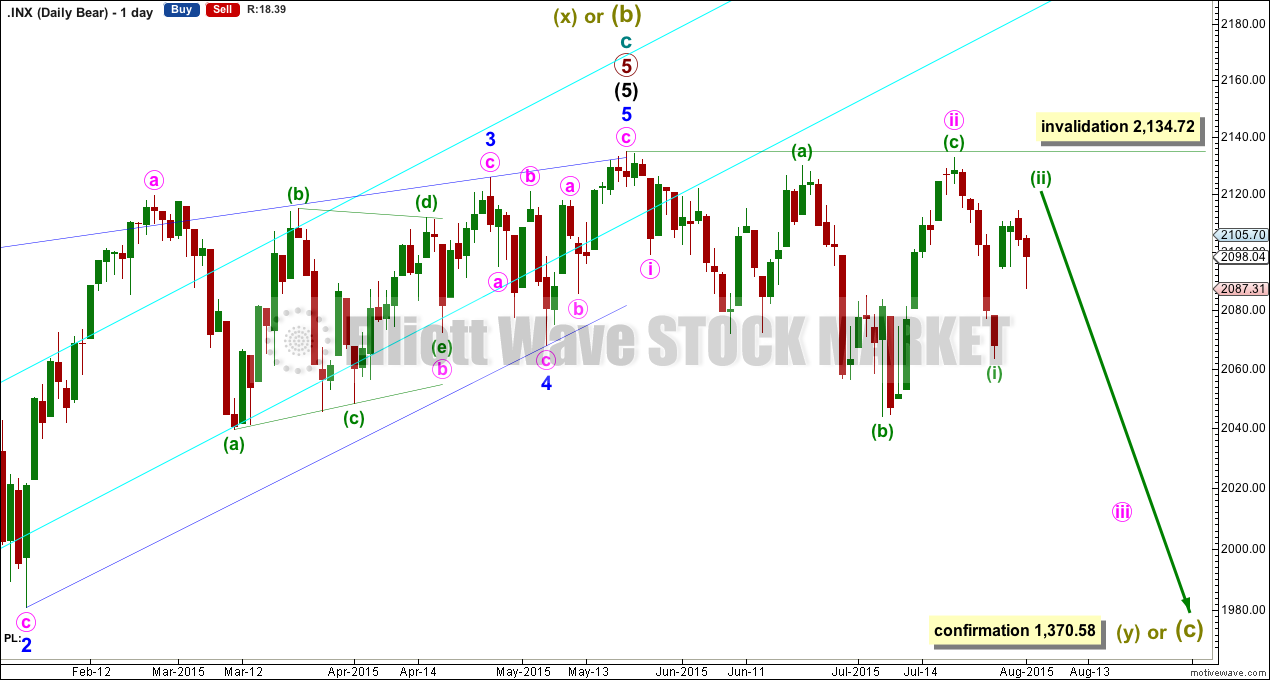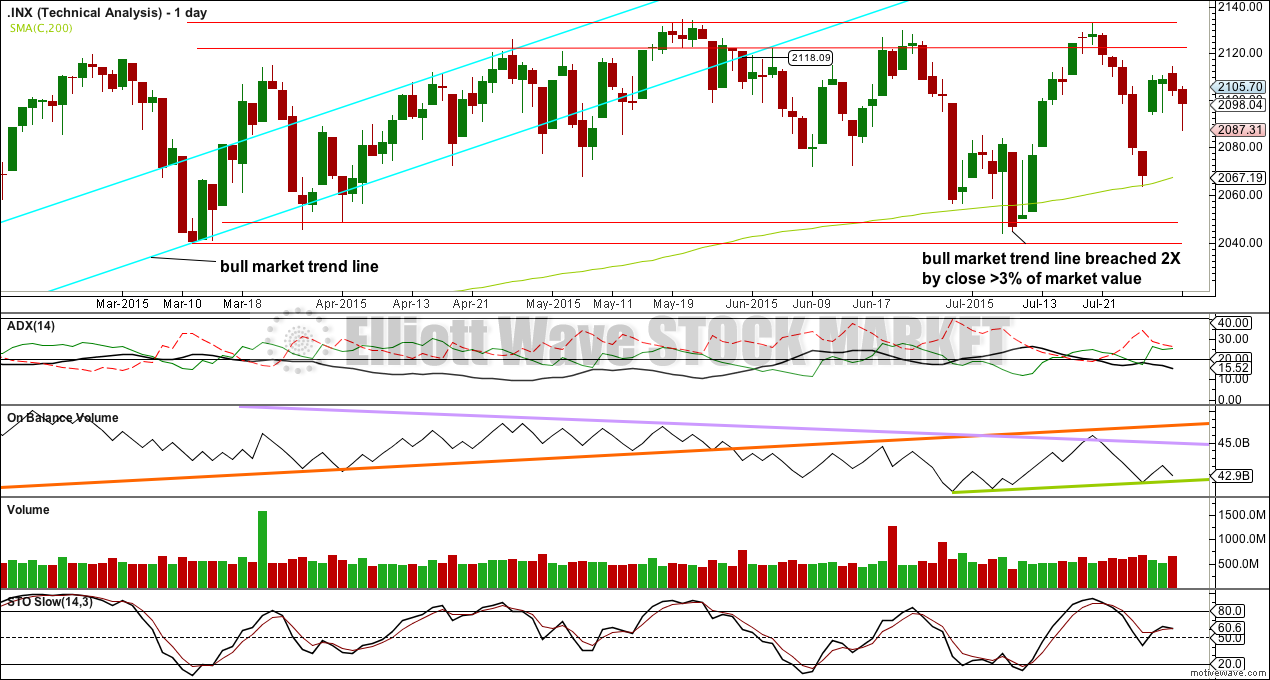Both Elliott wave counts and regular technical analysis expected this week to begin with downwards movement, which is exactly what happened.
Summary:For the short term, a little upwards movement at least to about 2,119 may begin tomorrow. This may end during tomorrow’s session, or it may take all day to produce a green candlestick. A new high above 2,132.82 would invalidate the first wave count and confirm the second. A new low below 2,063.52 would invalidate the second wave count and confirm the first. The first wave count expects the middle of a strong third wave down to begin this week, so if it is correct, then we should have clarification this week.
Changes to last analysis are bold.
To see a weekly chart and how to draw trend lines click here.
Note regarding data for 28th July session: I am still unable to get the Google / Yahoo data feed to provide that candlestick; it remains MIA. For today’s analysis, I am relying on the candlestick on daily charts published here.
FIRST ELLIOTT WAVE COUNT
It is possible that the S&P has seen a primary degree (or for the bear count below a Super Cycle degree) trend change.
If primary wave 3 is over then primary wave 4 should begin.
Primary wave 2 was a relatively shallow 0.41 zigzag lasting 12 weeks. Primary wave 4 may be more shallow and is most likely to be a flat, combination or triangle. It may be longer lasting than primary wave 2 as these types of sideways corrective structures tend to be more time consuming than zigzags. Primary wave 4 is likely to end in the price territory of the fourth wave of one lesser degree between 1,730 – 1,647. It may last about 13 or maybe even 21 weeks. So far it has completed its tenth week.
This wave count now has some confirmation at the daily chart level with a close more than 3% of market value below the long held bull market trend line.
Further confirmation would come with:
1. A new low below 2,044.02.
2. A new low below 2,022.07 to invalidate the second wave count.
3. A clear five down on the hourly chart.
4. A clear five down on the daily chart.
5. A new low below 1,820.66.
6. A break below the 50 week SMA on the weekly chart or the 200 day SMA on the daily chart.
As each condition is met the probability of a substantial trend change would increase.
At this stage, a trend change is looking somewhat likely so I’ll list points in its favour:
1. The long held bull market trend line, the strongest piece of technical analysis on ALL charts, has been breached now by a close more than 3% of market value.
2. There is quadruple negative divergence between price and MACD on the weekly chart.
3. There is double negative divergence between price and MACD on the daily chart.
4. There is persistent and strong negative divergence between price and RSI on the monthly chart. The last time this happened was October 2007 and we all know what happened after that…
5. A long held bull trend line on On Balance Volume going back to October 2014 has been breached, is no longer providing support, and is now providing resistance.
6. DJT has recently failed to confirm the continuation of a bull market. This does not indicate a bear market, but does indicate caution.
A target for minute wave iii is added now to the daily chart and explained below. Minute wave iii should show its subdivisions clearly on the daily chart so that when it is done it has a clear five wave impulse look to it. So far minuette wave (ii) shows up clearly. When it arrives minuette wave (iv) should also show up clearly. Minuette wave (iii) next week should show a strong increase in downwards momentum.
Downwards movement for Monday’s session fits best and looks like a three wave zigzag. This is probably subminuette wave b within a bigger deep zigzag for minuette wave (ii).
At 2,119 subminuette wave c would reach 0.618 the length of subminuette wave a. Subminuette wave c is very likely to make at least a slight new high above the end of subminuette wave a at 2,114.24 to avoid a truncation. Minuette wave (ii) may not move beyond the start of minuette wave (i) above 2,132.82.
Use Elliott’s technique to draw a parallel channel about this zigzag as shown. After some upwards movement to complete subminuette wave c, a subsequent breach of the lower edge of the channel by some downwards movement (not sideways) would provide trend channel confirmation that the middle of a third wave down should then have begun.
SECOND ELLIOTT WAVE COUNT
The ending contracting diagonal may still be incomplete. Ending diagonals require all sub waves to subdivide as zigzags, and the fourth wave should overlap first wave price territory. It is Elliott wave convention to always draw the diagonal trend lines to indicate a diagonal structure is expected.
My labelling here of minute wave iv within the diagonal as a double zigzag relies upon the interpretation of “double and triple zigzags take the place of zigzags” (“Elliott Wave Principle” by Frost and Prechter, 10th edition, page 91) to be true for zigzags within diagonals. This wave down may also be labelled as a single zigzag, but that does not have as neat a fit as a double zigzag.
The diagonal trend lines are no longer clearly converging. This reduces the probability of this wave count.
If it moves any lower, then minute wave iv may not be longer than equality in length with minute wave ii at 2,022.07. If it is over here, then minute wave v up also has a limit and may not be longer than equality with minute wave iii at 2,197.84.
The best way to see where and when upwards movement may end is the upper diagonal i-iii trend line. It is very likely to be overshot. Upwards movement may find resistance at the long held bull market trend line.
Minuette wave (c) upwards may only subdivide as an ending diagonal or an impulse. It is highly unusual for an ending diagonal to complete an ending diagonal, so an impulse for minuette wave (c) is much more likely.
Subminuette wave ii looks like a three wave structure at the hourly chart level, falling just short of the 0.618 Fibonacci ratio of subminuette wave i. This second wave count also expects upwards movement tomorrow, but for a third wave. A new high above 2,132.82 would provide strong confidence in this second wave count.
BEAR ELLIOTT WAVE COUNT
The subdivisions within cycle waves a-b-c are seen in absolutely exactly the same way as primary waves 1-2-3 for the main wave count.
In line with recent Grand Super Cycle wave analysis, I have moved the degree of labelling for the bear wave count all up one degree.
This bear wave count expects a Super Cycle wave (c) to unfold downwards for a few years, and if it is a C wave it may be devastating. It may end well below 666.79.
However, if this wave down is a Super Cycle wave (y), then it may be a time consuming repeat of the last big flat correction with two market crashes within it, equivalent to the DotCom crash and the recent Global Financial Crisis, and it may take another 8-9 years to unfold sideways.
Within the new bear market, no second wave correction may move beyond the start of its first wave above 2,134.72.
The second wave count above works in the same way for this bear wave count.
TECHNICAL ANALYSIS
ADX is below 20 and declining. ADX indicates there is no clear trend and the market is consolidating. Recently rises in price are accompanied by ADX indicating no trend, and the last two falls in price were accompanied by ADX indicating the early stages of a trend (which was down) at least at the end. Overall it does look like a downwards trend may be developing, and there is at least no indication from ADX that an upwards trend may be still in place.
A range bound trading system may be better used than a trend following system. This would still expect some more downwards movement, to not end until price finds support at the lower two red horizontal trend lines and Stochastics is oversold at the same time.
As price turns down to reach support, if On Balance Volume breaks below its short held green trend line, that would be another reasonably bearish indicator.
Along the way down, price may again find support about the 200 day SMA (green). If price breaks clearly below that line, then it would be a very bearish indicator; a bounce at least or an end to downwards movement should initially be expected there. If Stochastics reaches oversold while price finds support at the 200 day SMA, then it may be where downwards movement ends, but only as long as ADX continues to indicate no clear trend.
The last two daily candlesticks are red and have increasing volume (although a volume bar is not seen for Monday’s session yet, Yahoo data shows Monday had stronger volume than Friday). This fall in price is again supported by volume, indicating that downwards movement is with the trend and upwards movement is against the trend. This has happened recently and was followed by new all time highs so it may not be reliable. It is also possible that the unusual volume profiles seen recently for the S&P 500 are a warning of something very big to the downside to come, a canary in the mine indicating the very bearish Elliott wave count could be correct.
A note on Dow Theory: for the bear wave count I would wait for Dow Theory to confirm a huge market crash. For that to be confirmed the following new lows are needed:
S&P500: 1,820.66
Nasdaq: 4,116.60
DJT: 7,700.49
DJIA: 15,855.12
At this time DJT is closest, but none of these indices have made new major swing lows yet.
This analysis is published about 06:47 p.m. EST.







Another 52 week low today for UVXY at what may be another second wave up.
Thanks so several reverse splits over the last few years, before this bear market is over UVXY is going to trade higher by a few orders of magnitude. Considering the risks to global markets, the level of optimism is truly remarkable. Patiently holding August expiration calls.